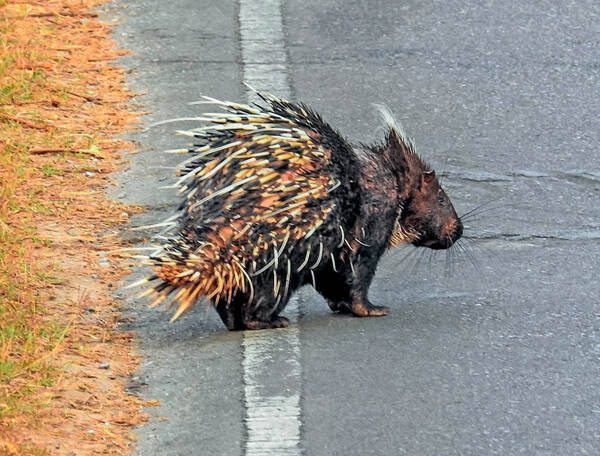Hystrix brachyura
IUCN
LCBasic Information
Scientific classification
- name:Hystrix brachyura
- Scientific Name:Hystrix brachyura
- Outline:Rodents
- Family:Rodentia Porcupineidae Porcupine
Vital signs
- length:630-720mm
- Weight:
- lifetime:
Feature
It has a large body, a brown-black head, and a white longitudinal stripe in the center of the forehead. The spines inside this longitudinal stripe are slender and bristle-like.
Distribution and Habitat
In China, it is distributed marginally in the southwest and south of Yunnan. Abroad, it is distributed in Bangladesh, India, Indonesia, Laos, Malaysia, Myanmar, Nepal, Thailand, and Vietnam.
Appearance
The body is strong. The body length is 630-720mm. The tail length is 80-140mm. There are flat spines on the sides of the body and the chest. The whole body is black or dark brown. Usually, the head and neck have slender, straight and backward-curved bristles that can stand upright. The front half of the body is dark brown to black, and the back, buttocks and tail are all covered with thick, straight, black-brown and white spindle-shaped spines. These spines are hollow in the middle and are specialized from body hair. They are easy to fall off. Some of them have inverted hooks at the tip, like sharp arrows, very hard and sharp. The skin under the spines is covered with sparse long bristles, mainly white, with a dark band in the middle. The buttocks have long and dense spines, and the limbs and ventral surface are covered with short and soft spines. The dozens of spines at the end of the tail have evolved into hard hairs with bulging tips, shaped like a group of "little bells".
Details
The Malayan porcupine is the earliest species named in the genus Porcupine. Previously, there were as many as 11 subspecies or synonyms, and the Chinese porcupine (<Hystrix hodgsoni>) was also once a subspecies. The so-called "Chinese porcupine" is actually originated from Nepal. Yunnan once named a porcupine species, which was once a subspecies of the Malayan porcupine and is currently a subspecies of the Chinese porcupine. Therefore, there is still some controversy in the classification of porcupines, which needs further study. Pan Qinghua et al. (2007) recorded that in the Yingjiang area in western Yunnan, the Chinese porcupine and the Malayan porcupine were distributed in the same area. It was also pointed out that the nasal bone of the Malayan porcupine is relatively short, less than half the length of the skull, while the nasal bone of the Chinese porcupine is more than half the length of the skull. Therefore, Pan Qinghua et al. (2007) believed that the Chinese porcupine and the Malayan porcupine are both independent species.

Malayan porcupines are active mainly at night. They usually live in family units and live in burrows or rock crevices during the day. When encountering predators such as tigers, leopards and Asian jackals, they will quickly erect the spines on their necks and backs and slap the ground with their hind legs to scare off the enemy. If further threatened, they will rush sideways or backwards towards the enemy and attack with their spines. It eats fruits, bark, roots, leaves and fleshy plants, but also eats animal bones to sharpen its teeth and supplement calcium and phosphorus from hard thorns.








